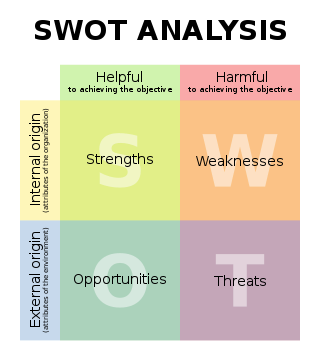Related Research Articles

In commerce, supply chain management (SCM) deals with a system of procurement, operations management, logistics and marketing channels so that the raw materials can be converted into a finished product and delivered to the end customer. A more narrow definition of the supply chain management is the "design, planning, execution, control, and monitoring of supply chain activities with the objective of creating net value, building a competitive infrastructure, leveraging worldwide logistics, synchronising supply with demand and measuring performance globally".This can include the movement and storage of raw materials, work-in-process inventory, finished goods, and end to end order fulfilment from the point of origin to the point of consumption. Interconnected, interrelated or interlinked networks, channels and node businesses combine in the provision of products and services required by end customers in a supply chain.
In the field of management, strategic management involves the formulation and implementation of the major goals and initiatives taken by an organization's managers on behalf of stakeholders, based on consideration of resources and an assessment of the internal and external environments in which the organization operates. Strategic management provides overall direction to an enterprise and involves specifying the organization's objectives, developing policies and plans to achieve those objectives, and then allocating resources to implement the plans. Academics and practicing managers have developed numerous models and frameworks to assist in strategic decision-making in the context of complex environments and competitive dynamics. Strategic management is not static in nature; the models can include a feedback loop to monitor execution and to inform the next round of planning.
In business, a competitive advantage is an attribute that allows an organization to outperform its competitors.

Porter's Five Forces Framework is a method of analysing the operating environment of a competition of a business. It draws from industrial organization (IO) economics to derive five forces that determine the competitive intensity and, therefore, the attractiveness of an industry in terms of its profitability. An "unattractive" industry is one in which the effect of these five forces reduces overall profitability. The most unattractive industry would be one approaching "pure competition", in which available profits for all firms are driven to normal profit levels. The five-forces perspective is associated with its originator, Michael E. Porter of Harvard University. This framework was first published in Harvard Business Review in 1979.

SWOT analysis is a strategic planning and strategic management technique used to help a person or organization identify Strengths, Weaknesses, Opportunities, and Threats related to business competition or project planning. It is sometimes called situational assessment or situational analysis. Additional acronyms using the same components include TOWS and WOTS-UP.
The word ‘dynamics’ appears frequently in discussions and writing about strategy, and is used in two distinct, though equally important senses.
Marketing strategy is an organization's promotional efforts to allocate its resources across a wide range of platforms, channels to increase its sales and achieve sustainable competitive advantage within its corresponding market.

Michael Eugene Porter is an American academic known for his theories on economics, business strategy, and social causes. He is the Bishop William Lawrence University Professor at Harvard Business School, and was one of the founders of the consulting firm The Monitor Group and FSG, a social impact consultancy. He is credited for creating Porter's five forces analysis, which is instrumental in business strategy development at present. He is generally regarded as the father of the modern strategy field. He is also regarded as one of the world's most influential thinkers on management and competitiveness as well as one of the most influential business strategists. His work has been recognized by governments, non governmental organizations and universities.
VRIO is a business analysis framework that forms part of a firm's larger strategic scheme, proposed by Jay Barney in 1991. The basic strategic process that any firm begins with a vision statement, and continues on through objectives, internal & external analysis, strategic choices, and strategic implementation.
The resource-based view (RBV) is a managerial framework used to determine the strategic resources a firm can exploit to achieve sustainable competitive advantage.
The knowledge-based theory of the firm considers knowledge as the most strategically significant resource of a firm. Its proponents argue that because knowledge-based resources are usually difficult to imitate and socially complex, heterogeneous knowledge bases and capabilities among firms are the major determinants of sustained competitive advantage and superior corporate performance.
Within international business, the diamond model, also known as Porter's Diamond or the Porter Diamond Theory of National Advantage, describes a nation's competitive advantage in the international market. In this model, four attributes are taken into consideration: factor conditions, demand conditions, related and supporting industries, and firm strategy, structure, and rivalry. According to Michael Porter, the model's creator, "These determinants create the national environment in which companies are born and learn how to compete."
In organizational theory, dynamic capability is the capability of an organization to purposefully adapt an organization's resource base. The concept was defined by David Teece, Gary Pisano and Amy Shuen, in their 1997 paper Dynamic Capabilities and Strategic Management, as "the firm’s ability to integrate, build, and reconfigure internal and external competences to address rapidly changing environments".
Hypercompetition, a term first coined in business strategy by Richard D’Aveni, describes a dynamic competitive world in which no action or advantage can be sustained for long. Hypercompetition is a key feature of the new global digital economy. Not only is there more competition, there is also tougher and smarter competition. It is a state in which the rate of change in the competitive rules of the game are in such flux that only the most adaptive, fleet, and nimble organizations will survive. Hypercompetitive markets are also characterized by a “quick-strike mentality” to disrupt, neutralize, or moot the competitive advantage of market leaders and important rivals.
Competitive heterogeneity is a concept from strategic management that examines why industries do not converge on one best way of doing things. In the view of strategic management scholars, the microeconomics of production and competition combine to predict that industries will be composed of identical firms offering identical products at identical prices. Deeper analyses of this topic were taken up in industrial organization economics by crossover economics/strategic-management scholars such as Harold Demsetz and Michael Porter. Demsetz argued that better-managed firms would make better products than their competitors. Such firms would translate better products or lower prices into higher levels of demand, which would lead to revenue growth. These firms would then be larger than the more poorly managed competitors.
Robert Morris Grant is a scholar and teacher of strategic management. He has held faculty positions at a number of business schools in the UK, Canada, and the US for years and is currently Professor of Strategic Management at Bocconi University in Milan. He is also a visiting professor at Georgetown University in Washington, DC, where he has held a position for 15 years.
{{Infobox academic | name = Shelby D. Hunt | othernames = | birth_date = 1939 | birth_place = | death_date = July 12, 2022 | death_place = Lubbock, Texas | nationality = American | occupation = Professor, author, consultant | spouse = | discipline = Marketing
Yves Doz is a French academic. He is a professor of strategic management at INSEAD, where he holds the Solvay Chaired Professorship of Technological Innovation, and is a Fellow of CEDEP. His research interests focus on innovation, the strategy and organization of multinational corporations, strategic alliances, and on how business organizations can develop the capability to adapt quickly to changes in competitive environments. More recently, he has been working with a number of national governments on strategic adaptability and agility. He is the author of numerous books and articles, which include the first comprehensive book on strategic alliances, co-authored with Gary Hamel, and the Multinational Mission, co-authored with CK Prahalad.

Jay B. Barney is an American professor in strategic management at the University of Utah.
The composition-based view (CBV) was recently developed by Luo and Child (2015). It is a new theory that explicates the growth of firms without the benefit of resource advantages, proprietary technology, or market power. The CBV complements some existing theories such as resource-based view (RBV), resource management view, and dynamic capability – to create novel insights into the survival of firms that do not possess such strategic assets as original technologies and brands. It emphasizes how ordinary firms with ordinary resources may generate extraordinary results through their creative use of open resources and unique integrating capabilities, resulting in an enhanced speed and a high price-value ratio that are well suited to large numbers of low- to mid-end mass market consumers. The CBV has been commented as “a new view with significant application” for emerging market firms and for small and medium sized enterprises in many countries. The view cautions though that composition-generated advantages are temporary in nature and that composition itself mandates special skills in distinctively identifying, leveraging, and combining open or existing resources inside and outside the firm.
References
- 1 2 Dyer, J.H., Singh, H. (1998): The relational view: Cooperative strategy and sources of interorganizational competitive advantage. Academy of Management Review, Vol. 23, pp. 660–679.
- ↑ Lavie, D. (2006): The competitive advantage of interconnected firms: An extension of the resource-based view. Academy of Management Review, Vol. 31, pp. 638–658.
- ↑ Porter, M.E. (1980): Competitive strategy. New York.
- ↑ Rumelt, R.P. (1984): Towards a strategic theory of the firm. In: R.B. Lamb (Ed.): Competitive strategic management. Englewood Cliffs, NJ. pp. 556-571.
- ↑ Rumelt, R.P. (1991): How much does industry matter? Strategic Management Journal, Vol. 12, pp. 167-185
- ↑ Wernerfelt, B. (1984): A resource based view of the firm. Strategic Management Journal, Vol. 5, pp. 171-180.
- ↑ Barney, J.B. (1991): Firm resources and sustained competitive advantage. Journal of Management, Vol. 17, pp. 99-120.
- ↑ Dyer, Jeffrey H.; Singh, Harbir (1998). "The Relational View: Cooperative Strategy and Sources of Interorganizational Competitive Advantage". The Academy of Management Review. Academy of Management. 23 (4): 662. doi:10.2307/259056. ISSN 0363-7425. JSTOR 259056.
- ↑ Klimczak, Karol Marek; Machowiak, Wojciech; Shachmurove, Yochanan; Staniec, Iwona (2020-08-28). "Perceived collaborative risk in small and medium technology enterprises". Journal of Small Business Management. Informa UK Limited. 61 (2): 540–559. doi:10.1080/00472778.2020.1799305. ISSN 0047-2778. S2CID 225238339.
- ↑ Zakrzewska-Bielawska, Agnieszka (2018-05-21). "Recognition of relational strategy content: insight from the managers' view". Eurasian Business Review . Springer Science and Business Media LLC. 9 (2): 193–211. doi: 10.1007/s40821-018-0109-9 . ISSN 1309-4297.